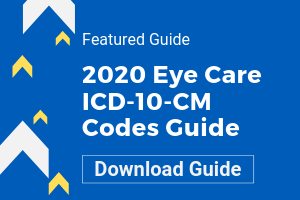
14 Aug ICD-10-CM Codes Guide: 2020 Updates for Eye Care Practices
Is your eye care practice preparing for the 2020 ICD-10-CM code changes? Do you know what eye-related diagnosis codes were added and deleted for fiscal year 2020?
2020 ICD-10-CM codes come into effect on October 1, 2019. Don’t wait until the last minute to review updated ICD-10-CM codes. Use this ICD-10-CM Codes Guide to start educating coders, billers, and providers now—so you can avoid delays in claim processing and/or rejected or denied claims later.
What is ICD-10-CM?
ICD-10-CM is a medical code that describes the condition and diagnoses of patients, whereas the ICD-10-PCS code describes inpatient procedures. A diagnosis code tells the insurance payer why you performed the service.
The World Health Organization (WHO) owns, develops, and publishes ICD codes. On June 21, 2019, the Centers for Medicare & Medicaid Services (CMS) and the Centers for Disease Control and Prevention (CDC) National Center for Health Statistics (NCHS) released the International Classification of Diseases, Tenth Edition (ICD-10-CM) code changes for 2020.
The 2020 ICD-10-CM code changes are the fourth mandated updates to the codes since the move from ICD-9 to ICD-10 went live on October 1, 2015. The ICD-10-CM 2020 fiscal year code release includes 72,184 diagnosis codes as compared to 71,932 in 2019. While that’s still a lot of codes, each year more codes are being invalidated (deleted).
How To Prepare for 2020 Eye Care ICD-10-CM Codes
How can you jump-start your optometric billing and coding before October 1, 2019? Here are 6 things to start doing now to stay on track.
- Review and become familiar with the new codes (download our 2020 Eye Care ICD-10-CM Codes guide) for optometry and ophthalmology billing. Claims that have a service date of September 30, 2019, or earlier, must include the 2019 codes to avoid a rejected or denied claim, while claims with a service date of October 1, 2019, or later, must use the new 2020 codes.
- If you have a “favorites” list in your EHR or practice management system, add new codes and remove the old codes.
- Review plans, assessments, and outbound documents in your ophthalmology or optometry software that were mapped from the old codes to the new codes.
- Review and update all “code rules” you created in your EHR and practice management software that need to change from the new and deleted 2020 codes.
- Be careful when using “copy from previous” as many ophthalmology and optometry software systems will copy over removed codes. Make sure the primary ICD-10 codes match the primary chief complaint and reason for the visit in the exam note.
- Check with your optometry (AOA.org) and ophthalmology (AAO.org) industry associations for specific coding changes and ICD-10 coding resources.
What Changed in 2020 for ICD-10-CM Codes?
Overall, for 2020, there are 273 new codes, 30 revised code descriptions, and 21 deleted codes. Of the new, revised and deleted codes, there are 68 new codes and 5 deleted codes for eye-related discharges and patient encounters occurring from October 1, 2019, through September 30, 2020.
ICD-10-CM codes are divided into 21 chapters, and codes are based on code subjects. The 2020 code updates affect the following four ICD-10-CM chapters.
- Chapter 8: Disease of the Ear and Mastoid Process (H60–H95). Removed ear references and made H81.4 (Vertigo of central origin) a reportable code; codes H81.41-49 (central nervous system origin) were deleted.
- Chapter 17: Congenital Malformations, Deformations and Chromosomal Abnormalities (Q00–Q99). Replaced Ehlers-Danlos syndrome (EDS) with new five-character options to indicate common and severe types of EDS.
- Chapter 19: Injury, Poisoning and Certain Other Consequences of External Causes (S00–T88). New subcategories specify fractures of the orbital roof and individual orbital walls often seen in facial trauma cases.
- Chapter 21: Factors Influencing Health Status and Contact with Health Services (Z00–Z99). Two new codes were added for an encounter following a failed exam.
Be Prepared With Our 2020 ICD-10-CM Codes Guide
The 2020 Eye Care ICD-10-CM Codes Guide includes the 68 new and 5 deleted eye-related codes. A bonus list of ICD-10 industry resources is included as well. Make your 2020 transition easier by downloading the guide.






